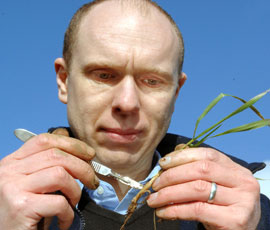Getting canopy management right will build yield

To achieve the optimum yield for your wheat crop, you need the right amount of leaf area capturing sunlight and feeding the right number of ears.
A thick crop won’t process light or nutrients efficiently and is prone to lodging. A thin crop won’t reach its potential.
Your early season management is critical in building a crop canopy that will get the balance just right.
What are the targets?
Crop canopy is measured in terms of Green Area Index (GAI) – the surface area of crop per unit area of ground.
You need a crop GAI of about 6 at Growth Stage 61, when flowering starts in early to mid June, so you need to decide your management by working back from here.
If plants or shoots have struggled, or have not received enough nitrogen, there will be a small canopy at this stage (for example, GAI of less than 4), which will waste sunlight.
Large canopies (above 7) will result from early sowing, high seed rates and high N supplies. These are at risk from disease and lodging.
The period of rapid growth starts in late April, as temperatures rise and the largest leaves emerge. At this point, you want the GAI to be about 3, and the canopy will expand at about 0.1 GAI a day.
The aim is to have about 500-600 ears per sq m at GS61, which means you are looking for this number of shoots per sq m.
At the end of tillering, you may have 1000 shoots per sq m, but many will die back as spring progresses.
Target plant number will depend on sowing date and possibly variety, but typically you will need between 100 and 250 plants/sq m to achieve the right number of ears.
Coming out of the winter with this target number will mean balancing management factors you can influence with some you cannot, such as weather and soil type.
A higher plant population can be achieved by:
• Drilling early
• Drilling a high seed rate
• Minimising slug damage.
From then on, you can manage the canopy by:
• Adjusting the amount and timing of fertiliser N applied
• Disease control measures.
How does nitrogen influence canopy?
Nitrogen availability will have the biggest influence on canopy development. Total crop uptake can be estimated by multiplying yield by 23 for feed wheat, or 25 for bread wheat. So a 10t/ha milling crop would need about 250kg/ha N.
It takes up 30kg/ha N for each unit of GAI, and recovers about 60% of fertiliser and 100% of soil mineral N during canopy expansion.
You should measure the soil mineral N during late winter, assessing N in the crop at the same time – a crop with a GAI of 1 has 30kg/ha N.
Taking into account the percentage recovery, you can calculate the fertiliser N needed for the target yield.
Applications made before stem extension will boost tiller numbers or maintain tiller survival. These will also encourage rooting, where take-all or compaction is a problem.
During stem extension, nitrogen applications will encourage shoot survival and increase leaf size. N uptake will be greatest during this period of rapid growth, so it should be applied before the crop pales, unless the canopy is excessive.
After stem extension, the N will prolong the survival of yield-forming leaves.
How can you reduce the risk of lodging?
All your careful canopy manipulation will go to waste if the crop goes flat before harvest.
Stem lodging is where the stem or shoot buckles above ground level. Root lodging will occur where the plant has insufficient anchorage.
Variety, sowing date, residual nitrogen and plant density all have a large impact on lodging risk. The more shoots a crop has, the more competition there is for limited resources, and the thinner, weaker stems will be more prone to buckling.
Residual soil nitrogen and early N applications significantly increase the likelihood of the crop lodging.
Plant growth regulators (PGRs) should be applied where the crop is at a high risk of lodging. Applied before third node detectable, these act by inhibiting cell growth, making the plant shorter.
At GS30, a GAI above 1 represents a higher than average lodging risk. A GAI above 1.5 is high risk at GS31.
They work best when the crop is actively growing, although Canopy (prohexadione-calcium + mepiquat chloride), Meteor (chlormequat + imazaquin) and Moddus (trinexapac-ethyl) are particularly useful at low temperatures.
A split dose, at GS30 and GS31, will bring better results. If there is a high lodging risk, any applications may have to be followed up later on.
Canopy, Cerone (2-chloroethylphosphonic acid) and Terpal (includes mepiquat) can be applied up to GS39.
- For more on canopy management and identifying Growth Stages 30 and 31, see our Canopy Management in Cereals webpage.

